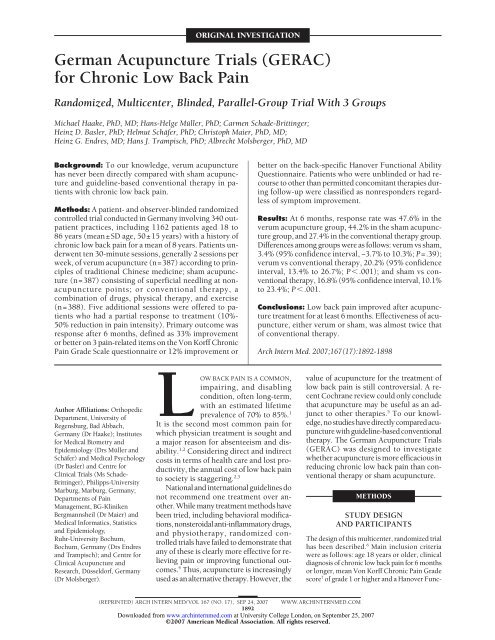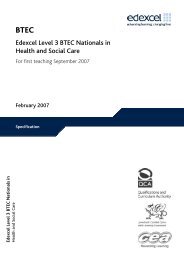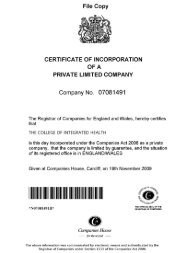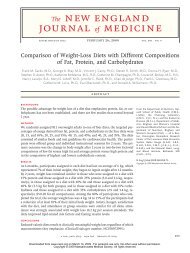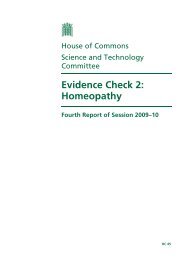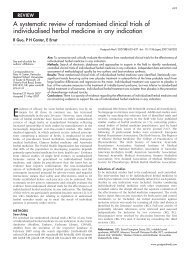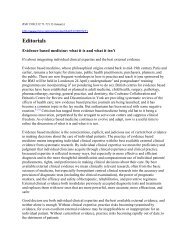German Acupuncture Trials (GERAC) for Chronic Low Back Pain
German Acupuncture Trials (GERAC) for Chronic Low Back Pain
German Acupuncture Trials (GERAC) for Chronic Low Back Pain
You also want an ePaper? Increase the reach of your titles
YUMPU automatically turns print PDFs into web optimized ePapers that Google loves.
ORIGINAL INVESTIGATION<br />
<strong>German</strong> <strong>Acupuncture</strong> <strong>Trials</strong> (<strong>GERAC</strong>)<br />
<strong>for</strong> <strong>Chronic</strong> <strong>Low</strong> <strong>Back</strong> <strong>Pain</strong><br />
Randomized, Multicenter, Blinded, Parallel-Group Trial With 3 Groups<br />
Michael Haake, PhD, MD; Hans-Helge Müller, PhD; Carmen Schade-Brittinger;<br />
Heinz D. Basler, PhD; Helmut Schäfer, PhD; Christoph Maier, PhD, MD;<br />
Heinz G. Endres, MD; Hans J. Trampisch, PhD; Albrecht Molsberger, PhD, MD<br />
<strong>Back</strong>ground: To our knowledge, verum acupuncture<br />
has never been directly compared with sham acupuncture<br />
and guideline-based conventional therapy in patients<br />
with chronic low back pain.<br />
Methods: A patient- and observer-blinded randomized<br />
controlled trial conducted in <strong>German</strong>y involving 340 outpatient<br />
practices, including 1162 patients aged 18 to<br />
86 years (mean±SD age, 50±15 years) with a history of<br />
chronic low back pain <strong>for</strong> a mean of 8 years. Patients underwent<br />
ten 30-minute sessions, generally 2 sessions per<br />
week, of verum acupuncture (n=387) according to principles<br />
of traditional Chinese medicine; sham acupuncture<br />
(n=387) consisting of superficial needling at nonacupuncture<br />
points; or conventional therapy, a<br />
combination of drugs, physical therapy, and exercise<br />
(n=388). Five additional sessions were offered to patients<br />
who had a partial response to treatment (10%-<br />
50% reduction in pain intensity). Primary outcome was<br />
response after 6 months, defined as 33% improvement<br />
or better on 3 pain-related items on the Von Korff <strong>Chronic</strong><br />
<strong>Pain</strong> Grade Scale questionnaire or 12% improvement or<br />
Author Affiliations: Orthopedic<br />
Department, University of<br />
Regensburg, Bad Abbach,<br />
<strong>German</strong>y (Dr Haake); Institutes<br />
<strong>for</strong> Medical Biometry and<br />
Epidemiology (Drs Müller and<br />
Schäfer) and Medical Psychology<br />
(Dr Basler) and Centre <strong>for</strong><br />
Clinical <strong>Trials</strong> (Ms Schade-<br />
Brittinger), Philipps-University<br />
Marburg, Marburg, <strong>German</strong>y;<br />
Departments of <strong>Pain</strong><br />
Management, BG-Kliniken<br />
Bergmannsheil (Dr Maier) and<br />
Medical In<strong>for</strong>matics, Statistics<br />
and Epidemiology,<br />
Ruhr-University Bochum,<br />
Bochum, <strong>German</strong>y (Drs Endres<br />
and Trampisch); and Centre <strong>for</strong><br />
Clinical <strong>Acupuncture</strong> and<br />
Research, Düsseldorf, <strong>German</strong>y<br />
(Dr Molsberger).<br />
LOW BACK PAIN IS A COMMON,<br />
impairing, and disabling<br />
condition, often long-term,<br />
with an estimated lifetime<br />
prevalence of 70% to 85%. 1<br />
It is the second most common pain <strong>for</strong><br />
which physician treatment is sought and<br />
a major reason <strong>for</strong> absenteeism and disability.<br />
1,2 Considering direct and indirect<br />
costs in terms of health care and lost productivity,<br />
the annual cost of low back pain<br />
to society is staggering. 2,3<br />
National and international guidelines do<br />
not recommend one treatment over another.<br />
While many treatment methods have<br />
been tried, including behavioral modifications,<br />
nonsteroidal anti-inflammatory drugs,<br />
and physiotherapy, randomized controlled<br />
trials have failed to demonstrate that<br />
any of these is clearly more effective <strong>for</strong> relieving<br />
pain or improving functional outcomes.<br />
4 Thus, acupuncture is increasingly<br />
used as an alternative therapy. However, the<br />
better on the back-specific Hanover Functional Ability<br />
Questionnaire. Patients who were unblinded or had recourse<br />
to other than permitted concomitant therapies during<br />
follow-up were classified as nonresponders regardless<br />
of symptom improvement.<br />
Results: At 6 months, response rate was 47.6% in the<br />
verum acupuncture group, 44.2% in the sham acupuncture<br />
group, and 27.4% in the conventional therapy group.<br />
Differences among groups were as follows: verum vs sham,<br />
3.4% (95% confidence interval, −3.7% to 10.3%; P=.39);<br />
verum vs conventional therapy, 20.2% (95% confidence<br />
interval, 13.4% to 26.7%; P�.001); and sham vs conventional<br />
therapy, 16.8% (95% confidence interval, 10.1%<br />
to 23.4%; P�.001.<br />
Conclusions: <strong>Low</strong> back pain improved after acupuncture<br />
treatment <strong>for</strong> at least 6 months. Effectiveness of acupuncture,<br />
either verum or sham, was almost twice that<br />
of conventional therapy.<br />
Arch Intern Med. 2007;167(17):1892-1898<br />
value of acupuncture <strong>for</strong> the treatment of<br />
low back pain is still controversial. A recent<br />
Cochrane review could only conclude<br />
that acupuncture may be useful as an adjunct<br />
to other therapies. 5 To our knowledge,<br />
no studies have directly compared acupuncture<br />
with guideline-based conventional<br />
therapy. The <strong>German</strong> <strong>Acupuncture</strong> <strong>Trials</strong><br />
(<strong>GERAC</strong>) was designed to investigate<br />
whether acupuncture is more efficacious in<br />
reducing chronic low back pain than conventional<br />
therapy or sham acupuncture.<br />
METHODS<br />
STUDY DESIGN<br />
AND PARTICIPANTS<br />
The design of this multicenter, randomized trial<br />
has been described. 6 Main inclusion criteria<br />
were as follows: age 18 years or older, clinical<br />
diagnosis of chronic low back pain <strong>for</strong> 6 months<br />
or longer, mean Von Korff <strong>Chronic</strong> <strong>Pain</strong> Grade<br />
score 7 of grade 1 or higher and a Hanover Func-<br />
(REPRINTED) ARCH INTERN MED/ VOL 167 (NO. 17), SEP 24, 2007 WWW.ARCHINTERNMED.COM<br />
1892<br />
Downloaded from<br />
www.archinternmed.com at University College London, on September 25, 2007<br />
©2007 American Medical Association. All rights reserved.
Table 1. Eligibility Criteria<br />
Inclusion Criteria<br />
Signed written in<strong>for</strong>med consent<br />
Clinical diagnosis of chronic low back pain <strong>for</strong> 6 mo or longer<br />
CPGS grade I and HFAQ less than 70%<br />
Therapy-free interval 7dorlonger<br />
Older than 18 y<br />
Ability to speak, read, and write <strong>German</strong><br />
Exclusion criteria<br />
Treatment with needle acupuncture <strong>for</strong> low back pain at any time in<br />
the past<br />
Treatment with needle acupuncture <strong>for</strong> any other indication within<br />
the last year<br />
History of spinal fracture (eg, osteoporosis or trauma) or disc or<br />
spinal surgery<br />
Infections or tumors of the spine<br />
Systemic bone or joint disorders (eg, rheumatoid arthritis)<br />
Scoliosis or kyphosis<br />
Sciatica or chronic pain from other disease<br />
Hemorrhagic disorders or anticoagulant therapy<br />
Skin disease in the area of acupuncture<br />
Abuse of drugs or pain medication<br />
Pregnancy<br />
Epilepsy<br />
Patient included in any other studies<br />
Abbreviations: CPGS, Von Korff <strong>Chronic</strong> <strong>Pain</strong> Grade Scale; HFAQ, Hanover<br />
Functional Ability Questionnaire.<br />
tional Ability Questionnaire score of less than 70%, 8 no previous<br />
acupuncture <strong>for</strong> treatment of chronic low back pain, and<br />
signed in<strong>for</strong>med consent. Primary exclusion criteria were previous<br />
spinal surgery; previous spinal fractures, infectious, or<br />
tumorous spondylopathy; and chronic pain caused by other diseases<br />
6 (Table 1). Patients were made aware of the study through<br />
newspapers, magazines, radio, and television. A list of physicians<br />
participating in the randomized trials was available on<br />
the Internet or could be requested from the medical insurance<br />
companies or the study center. Only patients who had been<br />
therapy-free <strong>for</strong> at least 7 days were eligible <strong>for</strong> screening.<br />
Figure 1 shows participant progress through the study.<br />
<strong>Acupuncture</strong> was administered in 340 outpatient practices<br />
by physicians of various specializations who had at least 140<br />
hours of acupuncture training: 55% had undergone basic training<br />
(mean, 213 hours) and 45% had advanced training (mean,<br />
376 hours). The study physicians had practiced acupuncture<br />
<strong>for</strong> 2 to 36 years (median, 8.0 years). All took part in a 1-day<br />
training session with emphasis on acupuncture methods and<br />
study design. Each patient in the study practices was seen by<br />
the same physician-acupuncturist at each session. Independent<br />
telephone interviewers assessed outcome measures.<br />
The study was conducted in accord with International Conference<br />
on Harmonization [of Technical Requirements <strong>for</strong> the Registration<br />
of Pharmaceuticals <strong>for</strong> Human Use]–Good Clinical Practice<br />
(ICH/GCP) criteria, including independent regular monitoring<br />
and establishment of an independent data safety monitoring committee.<br />
All study participants provided written in<strong>for</strong>med consent<br />
and the study was approved by local ethics committees.<br />
INTERVENTIONS<br />
Patients were randomized to receive verum acupuncture, sham<br />
acupuncture, or guideline-based conventional therapy. All interventions<br />
comprised ten 30-minute sessions, generally 2 sessions<br />
per week, and 5 additional sessions if, after the tenth session<br />
(Figure 2), patients experienced a 10% to 50% reduction<br />
387 Allocated to verum<br />
acupuncture<br />
387 ITT<br />
370 at 6-wk Assessment<br />
17 Missed assessment<br />
373 at 3-mo Assessment<br />
14 Missed assessment<br />
377 at 6-mo Assessment<br />
10 Missed assessment<br />
1802 Participants assessed<br />
<strong>for</strong> eligibility<br />
1162 Participants were<br />
randomized<br />
387 Allocated to sham<br />
acupuncture<br />
387 ITT<br />
375 at 6-wk Assessment<br />
12 Missed assessment<br />
376 at 3-mo Assessment<br />
11 Missed assessment<br />
376 at 6-mo Assessment<br />
11 Missed assessment<br />
640 Participants were excluded<br />
342 Insufficient severity (HFAQ)<br />
233 Met exclusion criteria<br />
44 Withdrew in<strong>for</strong>med consent<br />
21 For other reasons<br />
388 Allocated to sham<br />
acupuncture<br />
1 Excluded <strong>for</strong><br />
pregnancy<br />
387 ITT<br />
361 at 6-wk Assessment<br />
26 Missed assessment<br />
361 at 3-mo Assessment<br />
26 Missed assessment<br />
364 at 6-mo Assessment<br />
25 Missed assessment<br />
Figure 1. Participant flowsheet. HFAQ indicates Hanover Functional Ability<br />
Questionnaire; ITT, intention to treat.<br />
in pain intensity (Von Korff <strong>Chronic</strong> <strong>Pain</strong> Grade Scale). 6 Interviewers<br />
and patients were blinded to this criterion. In all telephone<br />
interviews, patients were asked specifically about use<br />
of medication and physical therapy.<br />
The sterile, disposable needles (Asiamed, Pullach near Munich,<br />
<strong>German</strong>y) used <strong>for</strong> verum and sham acupuncture were<br />
identical and were either 0.25�40 mm or 0.35�50 mm. Only<br />
body needle acupuncture, without electrical stimulation or moxibustion,<br />
was allowed. Verum acupuncture consisted of needling<br />
fixed points and additional points (from a prescribed list)<br />
chosen individually on the basis of traditional Chinese medicine<br />
diagnosis, including tongue diagnosis. Fourteen to 20<br />
needles were inserted to a depth of 5 to 40 mm depending on<br />
location. Induction of de Qi (the sensation felt when an acupuncturist<br />
reaches the level of Qi [numb radiating sensation<br />
indicative of effective needling] in the body) was elicited by<br />
manual stimulation. Sham acupuncture on either side of the<br />
lateral part of the back and on the lower limbs was also standardized,<br />
avoiding all known verum points or meridians. As<br />
with verum acupuncture, 14 to 20 needles were inserted, but<br />
superficially (1-3 mm) and without stimulation.<br />
The methods of acupuncture and Chinese diagnosis were established<br />
on the basis of the international literature and a consensus<br />
process with international experts. The exact method of<br />
acupuncture has been published. 6,10 For acute episodes of pain,<br />
only rescue medication was permitted in both acupuncture<br />
groups. This was strictly defined as nonsteroidal antiinflammatory<br />
drugs to be taken on no more than 2 days per week<br />
up to the maximum daily dose during the therapy period and<br />
only 1 day per week during follow-up. Use of any additional therapies<br />
<strong>for</strong> pain during the entire study period was prohibited<br />
Patients in the conventional therapy group received a multimodal<br />
treatment program according to <strong>German</strong> guidelines. 11<br />
The guidelines provide the treating physician with recommendations<br />
about the treatment algorithm and assess the various<br />
therapy <strong>for</strong>ms according to the degree of evidence based on a<br />
literature search and recommendations of the specialist associations.<br />
Conventional therapy included 10 sessions with personal<br />
contact with a physician or physiotherapist who administered<br />
physiotherapy, exercise, and such.<br />
(REPRINTED) ARCH INTERN MED/ VOL 167 (NO. 17), SEP 24, 2007 WWW.ARCHINTERNMED.COM<br />
1893<br />
Downloaded from<br />
www.archinternmed.com at University College London, on September 25, 2007<br />
©2007 American Medical Association. All rights reserved.
Patient consent <strong>for</strong> participation<br />
Physician checks eligibility criteria<br />
Patient receives questionnaires;<br />
physician reports patient to central<br />
data center using a fax<br />
–17 d<br />
Screening<br />
Primary contact<br />
interview<br />
∆ = 14 Days be<strong>for</strong>e baseline interview<br />
Physiotherapies were supported by nonsteroidal antiinflammatory<br />
drugs or pain medication up to the maximum<br />
daily dose during the therapy period. Rescue medication was<br />
identical to that <strong>for</strong> the acupuncture groups.<br />
During acupuncture treatment, communication with the patient<br />
was limited to necessary explanations to avoid unblinding<br />
the patient by suggestive remarks. Patients in all 3 groups<br />
were in<strong>for</strong>med be<strong>for</strong>e randomization that acupuncture would<br />
be offered after completion of the trial.<br />
OUTCOME MEASURES<br />
Baseline interview<br />
plus primary<br />
outcome measure<br />
–3 d<br />
Baseline Phase<br />
Telephone interviews by trained employees of the study center<br />
were conducted at baseline and at 1 1 ⁄2, 3, and 6 months. Our primary<br />
outcome was treatment response 6 months after randomization,<br />
defined as 33% improvement or better on 3 pain-related<br />
itemsontheVonKorff<strong>Chronic</strong><strong>Pain</strong>GradeScale 7 or12%improvement<br />
or better on back-specific functional status measured by the<br />
Hanover Functional Ability Questionnaire. 8 Patients who had recourse<br />
to additional treatments other than rescue medication were<br />
classified as nonresponders, as were unblinded patients.<br />
Secondary outcomes were responder rate at 1 1 ⁄2 and 3 months<br />
after randomization, scores on the 12-item Short Form Health<br />
Survey, 12 and patient global assessment of therapy effectiveness<br />
on a scale of 1 (very good) to 6 (fail). 13 Physicians documented<br />
medication use, acupuncture treatment, and adverse events at<br />
each session and at the final examination after 6 months. Patient<br />
blinding was assessed at the 6-month interview by asking<br />
whether their physician had in<strong>for</strong>med them of their allocation<br />
and, if not, by asking the method of acupuncture and how certain<br />
they were of their response. 14 All interview questions were<br />
given to the patients during the baseline visit.<br />
RANDOMIZATION AND BLINDING<br />
Rechecking of<br />
eligibility criteria<br />
The 1:1:1 randomization was per<strong>for</strong>med dynamically by a computer<br />
program balancing <strong>for</strong> 2 levels of chronification (�2 or<br />
�2 years), 2 levels of fear avoidance belief 15 (�4or�4 average<br />
total points), 2 levels of activity (�60 or �60 minutes), patient<br />
expectations, 16 and trial center. The previous allocation scheme<br />
and a prespecified list of random numbers were used. After successful<br />
completion of the baseline interview and once the patient<br />
had come <strong>for</strong> the first treatment, the physician called a randomization<br />
hotline that registered the patient in the study and<br />
faxed the patient’s assigned treatment group to the physician.<br />
Patients were blinded to the type of acupuncture. They were<br />
told they would be treated with a traditional Chinese <strong>for</strong>m of<br />
Physician receives<br />
result of randomization<br />
from data center<br />
Start of treatment<br />
Figure 2. Study design <strong>for</strong> <strong>German</strong> <strong>Acupuncture</strong> Trial <strong>for</strong> <strong>Chronic</strong> <strong>Low</strong>er <strong>Back</strong> <strong>Pain</strong>. Adapted from Endres et al. 9<br />
Treatment extension<br />
(5 sessions)<br />
Telephone interviews<br />
acupuncture (verum), with a <strong>for</strong>m of acupuncture developed<br />
especially <strong>for</strong> this study (sham), or with conventional therapy.<br />
Investigators could not be blinded to the method of acupuncture,<br />
but the interviewers were.<br />
STATISTICAL ANALYSIS<br />
The primary analysis included all randomized patients on the<br />
intent-to-treat basis. Patients in all groups who missed the<br />
6-month-assessment were, there<strong>for</strong>e, classified as nonresponders.<br />
Response rates were tested <strong>for</strong> differences using the<br />
2-sided Fisher exact test. The multiple testing problem caused<br />
by the comparison of 3 treatment methods was handled by a<br />
closed test procedure to guarantee the type I error level of 5%<br />
<strong>for</strong> all pairwise comparisons. Two tests comparing verum acupuncture<br />
with the 2 control groups at a level of 2.5% each were<br />
per<strong>for</strong>med as a first step. 6 If this global test ruled out the null<br />
hypothesis of no difference among the 3 treatments, then all 3<br />
pairwise comparisons were per<strong>for</strong>med at a level of 5%. The study<br />
was powered to detect a change of 10% in response rates (verum<br />
acupuncture, 60%; conventional therapy, 50%; and sham acupuncture,<br />
40%), with 95% power <strong>for</strong> the global test. Assuming<br />
a 30% dropout rate, this led to a required sample size of<br />
354 patients per group. Exploratory analyses were per<strong>for</strong>med<br />
<strong>for</strong> all secondary end points. Sensitivity analyses included comparisons<br />
with grouping by treatment, dropping patients who<br />
missed the 6-month assessment, and best and worst imputation<br />
of missing data at 6-month assessment in all pairwise comparisons.<br />
RESULTS<br />
PARTICIPANTS<br />
Primary outcome<br />
measure<br />
0<br />
42 d<br />
90 d 180 d<br />
Treatment Phase<br />
10 Sessions<br />
Overall, 1802 patients with low back pain were screened,<br />
and 1162 were randomized between March 7, 2002 (first<br />
randomization), and December 12, 2004 (last randomization)<br />
(Figure 1). The primary reason <strong>for</strong> nonrandomization<br />
was insufficient severity of disability as measured<br />
with the Hanover Functional Ability Questionnaire.<br />
One patient dropped out because of pregnancy and was<br />
excluded from the primary analysis. Twenty-three patients<br />
in the intent-to-treat population in the conventional<br />
therapy group missed the 6-month telephone assessment<br />
and were, thus, classified as nonresponders. They<br />
(REPRINTED) ARCH INTERN MED/ VOL 167 (NO. 17), SEP 24, 2007 WWW.ARCHINTERNMED.COM<br />
1894<br />
Downloaded from<br />
www.archinternmed.com at University College London, on September 25, 2007<br />
©2007 American Medical Association. All rights reserved.
Table 2. Baseline Characteristics in 1162 Patients Randomized and 640 Patients Screened-Only a<br />
Baseline Characteristic<br />
Verum <strong>Acupuncture</strong><br />
(n = 387)<br />
were not included in a secondary sensitivity analysis,<br />
thereby statistically favoring the conventional therapy.<br />
This reduced the therapy effect in the response rates between<br />
acupuncture and conventional therapy by less than<br />
1%. Overall, the primary results remain stable. Balanced<br />
randomization ensured that there were no relevant differences<br />
between the 3 treatment groups insofar as the<br />
5 potentially prognostic factors (Table 2).<br />
TREATMENTS AND BLINDING<br />
A total of 13 475 treatment sessions were conducted<br />
(verum acupuncture, 4821 [mean, 12.5 per patient]; sham<br />
acupuncture, 4590 [mean, 11.9 per patient]; conventional<br />
therapy, 4064 [mean, 10.5 per patient]). Mean±SD<br />
treatment time per session was 30.5±2.5 minutes in all<br />
groups. The number of patients who received the 5 additional<br />
sessions was 232 (59.9%) in the verum group,<br />
209 (54.3%) in the sham group, and 192 (52.5%) in the<br />
conventional group. The therapies given in the conventional<br />
group were physiotherapy (n=197; mean, 11.7 sessions<br />
per patient), massage (n=180; mean, 9.5 sessions<br />
per patient), heat therapy (n=157; mean, 9.7 sessions per<br />
patient), electrotherapy (n=65; mean, 8.8 sessions per<br />
patient), back school (ie, a practical education in the management<br />
of back pain) (n=36; mean, 8.1 sessions per patient),<br />
injections (n=48; mean, 5.6 per patient), and guidance<br />
(n=56; mean, 4.2 sessions per patient). In a few<br />
patients, therapies included infusions, yoga, hydrojet treatment,<br />
and swimming. Pharmacologic treatment in the<br />
conventional therapy group consisted of analgesics in 95%<br />
of patients (n=183; mean, 16.2 per patient). At the end<br />
of the study, patients rated the credibility of both acupuncture<br />
<strong>for</strong>ms positively. Blinding seems to have been<br />
maintained: most patients did not correctly identify or<br />
did not know which <strong>for</strong>m they had received (Table 3).<br />
Primary outcome at 6 months could be assessed in 96.1%<br />
Sham <strong>Acupuncture</strong><br />
(n = 387)<br />
Standard Therapy<br />
(n = 388)<br />
(1117 patients [377 received verum; 376 sham, and 364<br />
standard treatment]) of all randomized patients.<br />
CLINICAL OUTCOMES<br />
Screened Only<br />
(n = 640)<br />
Sex, No.(%)<br />
Men 165 (42.6) 140 (36.2) 165 (42.5) 267 (41.7)<br />
Women 222 (57.4) 247 (63.8) 223 (57.5) 373 (58.3)<br />
Age, y 49.6 ± 14.6 (380) 49.2 ± 14.8 (382) 51.3 ± 14.5 (381) 48.5 ± 14.7 (619)<br />
Body mass index b 26.9 ± 4.7 (381) 26.5 ± 4.8 (378) 26.3 ± 4.5 (378) 26.1 ± 4.4 (614)<br />
Prognostic factors<br />
History of back pain, y 8.1 ± 7.7 (380) 7.7 ± 8.2 (382) 8.1 ± 8.3 (380) 7.6 ± 7.6 (617)<br />
Patient expectations c 7.6 ± 1.7 (387) 7.7 ± 1.8 (387) 7.7 ± 1.8 (388) 7.4 ± 1.9 (512)<br />
Fear avoidance beliefs d 3.3 ± 1.3 (387) 3.2 ± 1.3 (387) 3.3 ± 1.3 (388) 3.6 ± 1.2 (54)<br />
Physical activity, c min/d 70.5 ± 121.5 (377) 67.1 ± 119.3 (347) 67.5 ± 117.4 (381) 48.8 ± 106.9 (54)<br />
<strong>Pain</strong>, CPGS 67.7 ± 13.9 67.8 ± 13.2 67.8 ± 14.6 NA<br />
Disability, HFAQ 46.3 ± 14.7 46.3 ± 15.3 46.7 ± 14.5 NA<br />
Quality of life, SF-12 NA<br />
Physical component summary 31.8 ± 6.8 31.5 ± 6.9 31.6 ± 6.8<br />
Mental component summary 46.6 ± 12.3 46.6 ± 11.5 47.1 ± 11.6<br />
Abbreviations: GCPS, Von Korff <strong>Chronic</strong> <strong>Pain</strong> Grade Scale (low values better); HFAQ, Hanover Functional Ability Questionnaire (high values better); NA, not<br />
available; SF-12, 12-item Short-Form Health Survey (high values better).<br />
a Data are given as mean ± SD (number of patients) unless otherwise indicated.<br />
b Calculated as weight in kilograms divided by height in meters squared.<br />
c Not at all helpful, 0; extremely helpful, 10.<br />
d Beliefs about back pain caused by physical activity: not at all, 0; absolutely true, 6.<br />
Table 3. Assessment of Patient Blinding at End of Study a<br />
Type of<br />
<strong>Acupuncture</strong><br />
Received<br />
Verum<br />
(specific)<br />
Sham<br />
(nonspecific)<br />
Type of<br />
<strong>Acupuncture</strong><br />
Patients Stated<br />
They Had<br />
Received<br />
Level of Confidence<br />
of Patient Answers<br />
Certain Uncertain<br />
Total<br />
Specific 45 (42.5) 61 (57.5) 106 (28.1)<br />
Nonspecific 48 (44.0) 61 (56.0) 109 (28.9)<br />
Don’t know 126 (33.4)<br />
Missing 36 (9.5)<br />
377<br />
Specific 26 (30.2) 60 (69.8) 86 (22.9)<br />
Nonspecific 49 (39.5) 75 (60.5) 124 (33.0)<br />
Don’t know 141 (37.5)<br />
Missing 25 (6.6)<br />
376<br />
a Data are given as number (percentage).<br />
Table 4 gives the response rates and between-group differences<br />
at 6 months. Almost half of patients in the acupuncture<br />
groups but only one-fourth of patients in the<br />
conventional therapy group benefited. Because the P value<br />
of the comparison of verum acupuncture and conventional<br />
therapy is �2.5% and the P value of the comparison<br />
of sham acupuncture and conventional therapy is<br />
�5.0%, both differences are statistically significant according<br />
to the closed testing procedure.<br />
Verum acupuncture was not superior to sham acupuncture,<br />
with an observed difference of 3.4% (P=.39). Be<strong>for</strong>e<br />
applicationofthenonrespondercriterion,successrateswere<br />
about 30% greater; that is, in any group, about 25% of pa-<br />
(REPRINTED) ARCH INTERN MED/ VOL 167 (NO. 17), SEP 24, 2007 WWW.ARCHINTERNMED.COM<br />
1895<br />
Downloaded from<br />
www.archinternmed.com at University College London, on September 25, 2007<br />
©2007 American Medical Association. All rights reserved.
Table 4. Primary Outcome: Pairwise Comparison<br />
of Treatment Response 6 Months After Randomization a<br />
Treatment Response Intergroup Difference P Value b<br />
Group 1 vs group 3<br />
47.6 (42.4 to 52.6) vs<br />
27.4 (23.0 to 32.1)<br />
Group 2 vs group 3<br />
44.2 (39.2 to 49.3) vs<br />
27.4 (23.0 to 32.1)<br />
Group 1 vs group 2<br />
47.6 (42.4 to 52.6) vs<br />
44.2 (39.2 to 49.3)<br />
20.2 (13.4 to 26.7) �.001<br />
16.8 (10.1 to 23.4) �.001<br />
3.4 (−3.7 to 10.3) .39<br />
a Each group comprised 387 patients. Values are given as percentage of<br />
patients (95% confidence interval). Group 1, verum acupuncture; group 2,<br />
sham acupuncture; group 3, conventional therapy.<br />
b Unadjusted; Fisher exact test (intention-to-treat analysis).<br />
tients were classified as nonresponders because they had recourse<br />
to additional therapies (Table 5). Patients in both<br />
acupuncture groups also had clinically meaningful better<br />
results<strong>for</strong>allsecondaryoutcomemeasures,includingmedication<br />
use (Table 6). No center effects were found.<br />
ADVERSE EVENTS<br />
During the 6 months after randomization, 40 serious adverse<br />
events were documented, 12 each in the verum and<br />
sham acupuncture groups and 16 in the conventional<br />
therapy group. All were deemed unrelated to the intervention.<br />
The number of serious adverse events corresponds<br />
to the statistically expected frequency. 17 In addition,<br />
476 clinically relevant adverse effects were reported<br />
by 257 patients (22.6%), with no significant difference<br />
between therapy groups (P=.81).<br />
COMMENT<br />
To our knowledge, the present study is the largest and most<br />
rigorous trial to investigate the efficacy of verum acupuncture<br />
<strong>for</strong> chronic low-back pain compared with sham acupuncture<br />
and guideline-based conventional therapy. The<br />
study yielded several surprising results. First, almost half of<br />
the patients in both acupuncture groups were responders.<br />
They experienced clinically relevant improvement in pain<br />
intensity or back-specific disability without having recourse<br />
toconcomitanttherapies.Second,onlyone-fourthofthepatients<br />
receiving conventional therapy, consisting of a multimodal<br />
combination of pharmacologic and nonpharmacologic<br />
treatments, responded to treatment. <strong>Acupuncture</strong>, regardless<br />
of the technique, was significantly more effective<br />
than conventional therapy at all follow-up points. To our<br />
knowledge, this is the first time superiority of acupuncture<br />
over conventional treatment has been unequivocally demonstrated<br />
<strong>for</strong> the primary and secondary outcomes, includingmedicationreduction,incontrasttostudieswithausualcare<br />
group. 5,18 Third, there was essentially no difference between<br />
the results <strong>for</strong> verum and sham acupuncture.<br />
What conclusions can be drawn from these findings?<br />
First, the unexpected finding of similar effectiveness of<br />
sham and verum acupuncture <strong>for</strong>ces us to question the<br />
underlying action mechanism of acupuncture and to ask<br />
Table 5. Treatment Response After 6 Months a<br />
Treatment Response<br />
Conventional<br />
Therapy<br />
Sham<br />
<strong>Acupuncture</strong><br />
Verum<br />
<strong>Acupuncture</strong><br />
CPGS<br />
Success b 132 (34.1) 197 (50.9) 229 (59.2)<br />
HFAQ<br />
Success c 195 (50.4) 251 (64.9) 281 (72.6)<br />
Combined CPGS and HFAQ<br />
Success d 223 (57.6) 277 (71.6) 304 (78.5)<br />
Total No. of patients 387 387 387<br />
Combined GCPS, HFAQ,<br />
and unblinded patients<br />
Nonresponders e 164 (42.4) 125 (32.3 112 (28.9)<br />
Responders 223 (57.6) 262 (67.7) 275 (71.1)<br />
Overall treatment response<br />
including proscribed<br />
rescue medication<br />
Nonresponders f 281 (72.6) 216 (55.8) 203 (52.4)<br />
Responders 106 (27.4) 171 (44.2) 184 (47.6)<br />
Total No. of Patients 387 387 387<br />
Abbreviations: CPGS, Von Korff <strong>Chronic</strong> <strong>Pain</strong> Grade Scale; HFAQ, Hanover<br />
Functional Ability Questionnaire <strong>for</strong> measuring back pain–related functional<br />
limitations.<br />
a Values are given as number of patients (percentage).<br />
b Success was defined as 33% improvement or better on 3 pain-related items<br />
on the GCPS.<br />
c Success was defined as 12% improvement or better on the back-specific<br />
HFAQ.<br />
d Success was defined as 33% improvement or better on 3 pain-related items<br />
on the CPGS or as 12% improvement or better on the back-specific HFAQ.<br />
e Patients who had no success in the combined CPGS, HFAQ, or unblinded<br />
groups.<br />
f Patients who had no success in the combined CPGS, HFAQ, or unblinded<br />
groups; missed the 6-month assessment; or had recourse to other than<br />
permitted concomitant therapies during follow-up, regardless of symptom<br />
improvement.<br />
whether the emphasis placed on learning the traditional<br />
Chinese acupuncture points may be superfluous. Second,<br />
while all randomized trials and meta-analyses to date<br />
have failed to show a clear advantage of acupuncture over<br />
conventional therapy <strong>for</strong> chronic low back pain, our findings<br />
demonstrate significant superiority.<br />
A recently published meta-analysis of acupuncture <strong>for</strong><br />
low back pain 19 concluded that “Current preliminary data<br />
suggest that acupuncture may be more effective than ineffectivecontrols<strong>for</strong>providingshort-termreliefofchroniclowback<br />
pain.” 20(p692) In contrast, we show superiority over an<br />
activecontrolgroup.Thenonsuperiorityofverumoversham<br />
acupuncture found in our study is in agreement with a recentlypublishedstudy<br />
21 thatwasconductedatthesametime<br />
as ours.<br />
The comparison of sham vs verum acupuncture was intended<br />
to differentiate the physiologic (specific) from the<br />
psychologic (nonspecific) effects of acupuncture. Among<br />
the nonspecific effects <strong>for</strong> both <strong>for</strong>ms of acupuncture are<br />
positivepatientexpectationsaboutacupuncturepairedwith<br />
negative expectations about conventional medicine, more<br />
intensive physician contact, and the experience of an invasive<br />
technique (needling). Given that the 2 <strong>for</strong>ms of acupunctureareindistinguishabletothepatient,anydifferences<br />
in outcomes between the 2 <strong>for</strong>ms must be attributable to<br />
specific treatment effects. However, the 2 <strong>for</strong>ms did not dif-<br />
(REPRINTED) ARCH INTERN MED/ VOL 167 (NO. 17), SEP 24, 2007 WWW.ARCHINTERNMED.COM<br />
1896<br />
Downloaded from<br />
www.archinternmed.com at University College London, on September 25, 2007<br />
©2007 American Medical Association. All rights reserved.
Table 6. Results <strong>for</strong> Secondary End Points in 3 Therapy Groups<br />
Secondary End Point<br />
Treatment response<br />
Verum <strong>Acupuncture</strong> Sham <strong>Acupuncture</strong> Conventional Therapy<br />
6wka 60.7 (387) 59.2 (387) 56.1 (387)<br />
3mob Disability, HFAQ<br />
55.0 (387) 51.9 (387) 41.9 (387)<br />
b<br />
Baseline 46.3 ± 14.7 (387) 46.3 ± 15.3 (387) 46.7 ± 14.5 (387)<br />
6 wk 64.0 ± 21.1 (370) 61.3 ± 20.8 (375) 56.3 ± 20.8 (361)<br />
3 mo 65.4 ± 22.9 (373) 61.3 ± 22.7 (376) 56.0 ± 22.0 (361)<br />
6 mo<br />
<strong>Pain</strong>, CPGS<br />
66.8 ± 23.1 (377) 62.2 ± 23.0 (376) 55.7 ± 22.7 (364)<br />
c<br />
Baseline 67.7 ± 13.9 (387) 67.8 ± 13.2 (387) 67.8 ± 14.6 (387)<br />
6 wk 48.6 ± 18.5 (370) 51.0 ± 18.7 (375) 57.1 ± 16.5 (361)<br />
3 mo 45.4 ± 19.4 (373) 48.5 ± 19.5 (376) 54.8 ± 18.4 (361)<br />
6 mo<br />
Quality of life, SF-12 physical score<br />
40.2 ± 22.5 (377) 43.3 ± 23.0 (376) 52.3 ± 21.2 (364)<br />
d<br />
Baseline 31.8 ± 6.8 (385) 31.5 ± 6.9 (386) 31.6 ± 6.8 (384)<br />
3 mo 40.3 ± 10.1 (370) 39.2 ± 9.7 (372) 36.1 ± 8.9 (361)<br />
6 mo<br />
Quality of life, SF-12 mental score<br />
41.6 ± 10.5 (373) 39.5 ± 10.1 (372) 35.8 ± 9.5 (364)<br />
d<br />
Baseline 46.6 ± 12.3 (385) 46.6 ± 11.5 (386) 47.1 ± 11.6 (384)<br />
3 mo 50.5 ± 11.1 (370) 50.2 ± 11.0 (372) 48.6 ± 11.6 (361)<br />
6 mo<br />
Patient global assessment<br />
50.7 ± 11.1 (373) 50.9 ± 10.8 (372) 49.2 ± 11.8 (364)<br />
c<br />
6 wk 2.8 ± 1.2 (369) 3.1 ± 1.4 (375) 3.5 ± 1.3 (360)<br />
3 mo 2.8 ± 1.3 (371) 3.1 ± 1.4 (376) 3.6 ± 1.3 (359)<br />
6 mo 2.8 ± 1.3 (376) 3.0 ± 1.4 (375) 3.5 ± 1.3 (362)<br />
Study cessation, No. (%) 34 (8.8) 39 (10.1) 50 (12.9)<br />
Abbreviations: CPGS, Von Korff <strong>Chronic</strong> <strong>Pain</strong> Grade Scale; HFAQ, Hanover Functional Ability Questionnaire; SF-12, 12-item Short-Form Health Survey.<br />
a Treatment response after 6 weeks was defined as 33% improvement or better on 3 pain-related items on the CPGS or 12% improvement or better on the<br />
back-specific HFAQ. Patients in the acupuncture groups who had recourse to other than permitted concomitant therapies during the study were classified as<br />
nonresponders regardless of symptom improvement.<br />
b Treatment response after 3 months was defined as 33% improvement or better on 3 pain-related items on the CPGS or 12% improvement or better on the<br />
back-specific HFAQ. Patients who had recourse to other than permitted concomitant therapies during the therapy and follow-up up to 3 months were classified as<br />
nonresponders regardless of symptom improvement.<br />
c <strong>Low</strong> values better.<br />
d High values better.<br />
ferinsofarastheprimaryoutcome.Thiscannotbeexplained<br />
solelybypositingtheexistenceofadditional,previouslyunknown<br />
acupuncture points or regions because in the sham<br />
acupuncture, needles were inserted only very shallowly and<br />
without elicitation of de Qi. Several other hypotheses must<br />
be considered instead: (1) there are no specific acupuncture<br />
effects at all; (2) the specific acupuncture effect is very<br />
small and is overlaid by nonspecific effects; and (3) there<br />
exist specific acupuncture effects, the nature of which is still<br />
unknown,thatleadtosymptomimprovementindependent<br />
of point selection and depth of needling.<br />
The results <strong>for</strong> conventional therapy were significantly<br />
poorer than those in the 2 acupuncture groups. This raises<br />
questions about qualitative and quantitative aspects of conventional<br />
therapy. The number and duration of patienttherapist<br />
contacts were designed to be as similar as possible<br />
to those in the acupuncture groups. A comparison of<br />
the conventional therapy as delivered in our study with several<br />
studies of routine care in <strong>German</strong>y (eg, Chenot et al 22 )<br />
shows that the treatment in this study was superior in both<br />
quality and quantity. We, there<strong>for</strong>e, assume an efficient level<br />
of care <strong>for</strong> the conventional therapy arm.<br />
To minimize potential nocebo effects, participants had<br />
the opportunity to receive 10 acupuncture sessions after<br />
the completion of the study regardless of their as-<br />
signed group. Furthermore, every patient had the alternative<br />
of participating in a cohort study designed to<br />
examine the adverse effects of acupuncture therapy. 17 The<br />
advantage of this was that patients with positive expectations<br />
of acupuncture and negative expectations of conventional<br />
therapy could be excluded at the outset.<br />
The superiority of both <strong>for</strong>ms of acupuncture suggests<br />
a common underlying mechanism that may act on<br />
pain generation, transmission of pain signals, or processing<br />
of pain signals by the central nervous system and that<br />
is stronger than the action mechanism of conventional<br />
therapy. The underlying mechanism may be a kind of superplacebo<br />
effect produced by placebo and all nonspecific<br />
factors working together. Nevertheless, the effectiveness<br />
of acupuncture cannot be attributed merely to<br />
a placebo effect because there is no reason to believe that<br />
the action mechanism of conventional therapy is the result<br />
solely of the placebo effect. Nor can the conditions<br />
of a randomized trial be responsible <strong>for</strong> the unexpected<br />
success because the same success rates after 3 and 6<br />
months were measured under conditions of everyday practice.<br />
23 Nevertheless, the effectiveness of sham acupuncture<br />
and the principle of nihil nocere suggest that a discussion<br />
is called <strong>for</strong> about the necessary depth of insertion<br />
of acupuncture needles.<br />
(REPRINTED) ARCH INTERN MED/ VOL 167 (NO. 17), SEP 24, 2007 WWW.ARCHINTERNMED.COM<br />
1897<br />
Downloaded from<br />
www.archinternmed.com at University College London, on September 25, 2007<br />
©2007 American Medical Association. All rights reserved.
The strengths of our study include an active multimodal<br />
conventional therapy control group, high-power, regular<br />
monitoring, assessment of blinding maintenance, structured<br />
telephone interviews, a clinically relevant primary<br />
outcome, and a low dropout rate. Potential limitations of<br />
the study were restricting acupuncture to needling only,<br />
restricting the number of sessions to 10 to 15, and inability<br />
to blind acupuncturists to the <strong>for</strong>m of acupuncture. However,<br />
we believe that nonblinding of acupuncturists did not<br />
lead to major bias because patient blinding to type of acupuncture<br />
was maintained even <strong>for</strong> 6 months.<br />
<strong>Acupuncture</strong> constitutes a strong therapy alternative<br />
to multimodal conventional therapy. <strong>Acupuncture</strong> gives<br />
physicians a promising and effective treatment option <strong>for</strong><br />
chronic low back pain, with few adverse effects or contraindications.<br />
The improvements in all primary and<br />
secondary outcome measures were significant and lasted<br />
long after completion of treatment. Because they directly<br />
compared acupuncture and conventional therapy,<br />
the <strong>GERAC</strong> trials were the decisive trials on which the<br />
<strong>German</strong> Federal Joint Committee of Physicians and Health<br />
Insurance Plans, a body similar to the National Institute<br />
<strong>for</strong> Health and Clinical Excellence in the United Kingdom<br />
or the National Institutes of Health in the United<br />
States, based its decision to make acupuncture <strong>for</strong> chronic<br />
low back pain an insured benefit, <strong>for</strong> the first time putting<br />
acupuncture on an equal footing with conventional<br />
therapy.<br />
Accepted <strong>for</strong> Publication: May 20, 2007.<br />
Correspondence: Heinz G. Endres, MD, Department of<br />
Medical In<strong>for</strong>matics, Statistics and Epidemiology, Ruhr-<br />
Universität Bochum, Universitaetsstrasse 150, D-44801<br />
Bochum, <strong>German</strong>y (heinz.endres@ruhr-uni-bochum<br />
.de).<br />
Author Contributions: Dr Müller and Ms Schade-Brittinger<br />
had full access to all of the data in the study and take responsibility<br />
<strong>for</strong> the integrity of the data and the accuracy of the<br />
dataanalysis.Studyconceptanddesign:Haake,Müller,Schade-<br />
Brittinger, Basler, Schäfer, Maier, Endres, Trampisch, and<br />
Molsberger. Acquisition of data: Schade-Brittinger and Maier.Analysisandinterpretationofdata:Haake,Müller,Schade-<br />
Brittinger,Endres,andMolsberger.Draftingofthemanuscript:<br />
Haake,Müller,Schade-Brittinger,Basler,Schäfer,Maier,Endres,Trampisch,andMolsberger.Criticalrevisionofthemanuscript<strong>for</strong>importantintellectualcontent:Haake,Müller,Schade-<br />
Brittinger, Basler, Schäfer, Maier, Endres, and Molsberger.<br />
Statisticalanalysis:Müller,Schäfer,andTrampisch.Obtained<br />
funding: Schäfer. Administrative, technical, and material support:Schade-Brittinger,Basler,Maier,andMolsberger.Study<br />
supervision: Molsberger.<br />
Financial Disclosure: None reported.<br />
Funding/Support: This study was supported by the following<br />
<strong>German</strong> public health insurance companies: AllgemeineOrtskrankenkasse,Betriebskrankenkasse,Innungskrankenkasse,<br />
Bundesknappschaft, Bundesverband der Landwirtschaftlichen<br />
Krankenkassen, and Seekasse.<br />
Role of the Sponsors: The funders had no role in the design<br />
and conduct of the study; data collection, management,<br />
analysis, and interpretation of the data; or preparation,<br />
review, or approval of the manuscript.<br />
Additional Contributions: We thank the patients and colleagues<br />
in the participating centers involved in this project<br />
and the members of the independent data and safety monitoring<br />
committee <strong>for</strong> their recommendations. The staff<br />
of Winicker Norimed (Nuremberg) and the Coordination<br />
Centers <strong>for</strong> Clinical <strong>Trials</strong> of the Universities of<br />
Düsseldorf, Heidelberg, Mainz, and Marburg contributed<br />
to monitoring and study management (http://www<br />
.kks-netzwerk.de).<br />
REFERENCES<br />
1. Andersson GB. Epidemiological features of chronic low-back pain. Lancet. 1999;<br />
354(9178):581-585.<br />
2. Pai S, Sundaram LJ. <strong>Low</strong> back pain: an economic assessment in the United States.<br />
Orthop Clin North Am. 2004;35(1):1-5.<br />
3. Deyo RA, Weinstein JN. <strong>Low</strong> back pain. N Engl J Med. 2001;344(5):363-370.<br />
4. Carragee EJ. Clinical practice: persistent low back pain. N Engl J Med. 2005;352<br />
(18):1891-1898.<br />
5. Furlan AD, van Tulder MW, Cherkin DC, et al. <strong>Acupuncture</strong> and dry-needling <strong>for</strong><br />
low back pain. Cochrane Database Syst Rev. 2005;(1):CD001351.<br />
6. Haake M, Müller HH, Schade-Brittinger C, et al. The <strong>German</strong> multicenter, randomized,<br />
partially blinded, prospective trial of acupuncture <strong>for</strong> chronic lowback<br />
pain: a preliminary report on the rationale and design of the trial. J Altern<br />
Complement Med. 2003;9(5):763-770.<br />
7. Farrar JT, Portenoy RK, Berlin JA, Kinman JL, Strom BL. Defining the clinically<br />
important difference in pain outcome measures. <strong>Pain</strong>. 2000;88(3):287-294.<br />
8. Kohlmann T, Raspe H. The Hannover Functional Questionnaire fin ambulatory<br />
diagnosis of functional disability caused by backache [in <strong>German</strong>]. Rehabilitation<br />
(Stuttg). 1996;35(1):1-8.<br />
9. Endres HG, Zenz M, Schaub C, et al. <strong>German</strong> <strong>Acupuncture</strong> <strong>Trials</strong> (<strong>GERAC</strong>) address<br />
problems of methodology associated with acupuncture studies. Schmerz.<br />
2005;19(3):201-210.<br />
10. Molsberger AF, Streitberger K, Kraemer J, et al. Designing an acupuncture study,<br />
II: the nationwide, randomized, controlled <strong>German</strong> acupuncture trials on lowback<br />
pain and gonarthrosis. J Altern Complement Med. 2006;12(8):733-742.<br />
11. AKDÄ. Empfehlungen zur Therapie von Kreuzschmerzen. 2 ed. Düsseldorf, <strong>German</strong>y:<br />
Nexus GmbH; 2000.<br />
12. Gandek B, Ware JE, Aaronson NK, et al. Cross-validation of item selection and<br />
scoring <strong>for</strong> the SF-12 Health Survey in nine countries. J Clin Epidemiol. 1998;<br />
51(11):1171-1178.<br />
13. Collins SL, Edwards J, Moore RA, Smith LA, McQuay HJ. Seeking a simple measure<br />
of analgesia <strong>for</strong> mega-trials: is a single global assessment good enough?<br />
<strong>Pain</strong>. 2001;91(1-2):189-194.<br />
14. Vincent C, Lewith G. Placebo controls <strong>for</strong> acupuncture studies. J R Soc Med.<br />
1995;88(4):199-202.<br />
15. Waddell G, Newton M, Henderson I, Somerville D, Main CJA. Fear-Avoidance Beliefs<br />
Questionnaire (FABQ) and the role of fear-avoidance beliefs in chronic low<br />
back pain and disability. <strong>Pain</strong>. 1993;52(2):157-168.<br />
16. Kalauokalani D, Cherkin DC, Sherman KJ, Koepsell TD, Deyo RA. Lessons from<br />
a trial of acupuncture and massage <strong>for</strong> low back pain: patient expectations and<br />
treatment effects. Spine. 2001;26(13):1418-1424.<br />
17. Endres HG, Molsberger A, Lungenhausen M, Trampisch HJ. An internal standard<br />
<strong>for</strong> verifying the accuracy of serious adverse event reporting: the example of an<br />
acupuncture study of 190,924 patients. Eur J Med Res. 2004;9(12):545-551.<br />
18. Thomas KJ, MacPherson H, Ratcliffe J, et al. Longer term clinical and economic<br />
benefits of offering acupuncture care to patients with chronic low back pain. Health<br />
Technol Assess. 2005;9(32):1-109.<br />
19. Manheimer E, White A, Berman B, Forys K, Ernst E. Meta-analysis: acupuncture<br />
<strong>for</strong> low back pain [published correction appears in Ann Intern Med. 2005;142<br />
(11):950-951 and Ann Intern Med. 2005;143(9):691-693.]. Ann Intern Med. 2005;<br />
142(8):651-663.<br />
20. Shekelle P. <strong>Acupuncture</strong> <strong>for</strong> low back pain. Ann Intern Med. 2005;143(9):691-693.<br />
21. Brinkhaus B, Witt CM, Jena S, et al. <strong>Acupuncture</strong> in patients with chronic low back<br />
pain: a randomized controlled trial. Arch Intern Med. 2006;166(4):450-457.<br />
22. Chenot JF, Becker A, Leonhardt C, et al. Determinants <strong>for</strong> receiving acupuncture<br />
<strong>for</strong> LBP and associated treatments [published online ahead of print November<br />
17, 2006]. BMC Health Serv Res. 2006;6:149. doi:10.1186/1472-6963-6-149.<br />
23. Kukuk P, Lungenhausen M, Molsberger A, Endres HG. Long-term improvement<br />
in pain coping <strong>for</strong> cLBP and gonarthrosis patients following body needle acupuncture:<br />
a prospective cohort study. Eur J Med Res. 2005;10(6):263-272.<br />
(REPRINTED) ARCH INTERN MED/ VOL 167 (NO. 17), SEP 24, 2007 WWW.ARCHINTERNMED.COM<br />
1898<br />
Downloaded from<br />
www.archinternmed.com at University College London, on September 25, 2007<br />
©2007 American Medical Association. All rights reserved.


